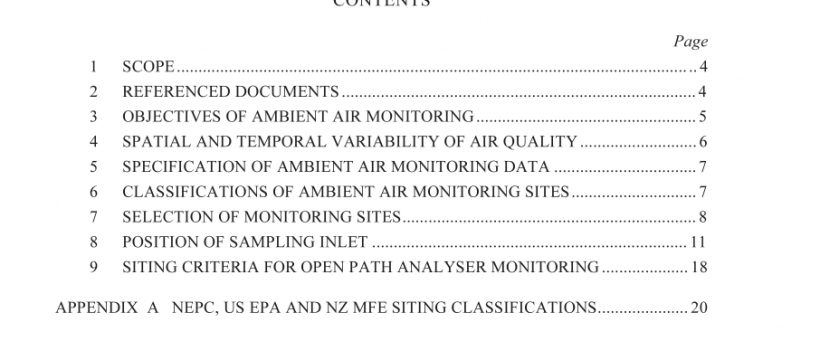AS NZS 3580.1.1:2016 pdf free download
AS NZS 3580.1.1:2016 pdf free download.Methods for sampling and analysis of ambient air
9 SITING CRITERIA FOR OPEN PATH ANALYSER MONITORING
Where an open path analyser is used (e.g. AS/NZS 3580.15), the criteria below are applicable.
The siting criteria are drawn from those developed by the US EPA in association with the use of open path analysers for ambient air quality monitoring (Environmental Protection Agency 1999 [Code of Federal Regulations, Title 40, Volume 5, Parts 58], [Revised as of July 1, 1999]).
These criteria are only intended to be a guide for siting such equipment, as it is recognized that specific monitoring objectives may necessitate deviation from these criteria. Deviations from these criteria should be noted in any monitoring data report, namely:
(a) If a significant portion of the beam is located along a wall, the beam should be installed on the windward side (relative to the prevailing wind) during the season of highest concentration potential.
(b) To avoid scavenging of pollutants, at least 90% of the path should have unrestricted air flow (e.g. not be mounted in a tunnel or similar).
(c) The beam shall be clear from trees, buildings, plumes and other optical obstructions. At the time of siting, consideration should be given to potential obstructions that may move due to wind, human activity or vegetation growth.
(d) At least 80% of the monitoring path shall comply with the height above ground criteria contain in Table 2 for the relevant pollutant.
(e) To avoid scavenging of reactive pollutants and wind turbulence effects, at least 90% of the path shall be more than 20 m away from the dripline of trees.
(f) If monitoring sulfur dioxide or ozone, at least 90% of the path length should be away from minor sources of sulfur dioxide and nitric oxide to avoid measurement of inappropriately high concentration of sulfur dioxide in the vicinity of the light path (unless this is the objective of monitoring) or unrepresentatively low concentration of ozone due to scavenging of ozone by nitric oxide.
AS NZS 3580.1.1:2016 pdf free download
